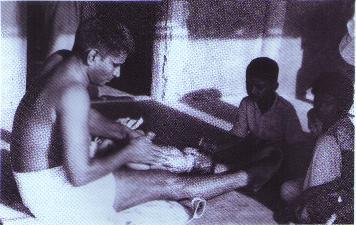THE MAKING OF BABA AMTE ... contd

Meanwhile, Muralidhar was elected Vice president of the Warora Municipal Corporation. When the night soil carriers went on strike, Muralidhar decided he would have to experience their hardships if he was to understand their grievances. So he went to work cleaning the town's latrines. For nine months he worked as a scavenger, carrying baskets filled with night soil on his head.
One rainy evening, as he walked home after a hard day's work, he had an experience which changed him forever, which revealed to him his mission in 1ife. A huddled figure lay on the roadside. At first it seemed like a bundle of rags . But with a shock he realized that it was not only human, it was alive.
"A man in the ultimate stages of leprosy. A rotting mass of human flesh with two holes in place of a nose, without a trace of fingers or toes, with worms and sores where there should have been eyes".
Horrified at the sight, terrified of infection, he ran from the scene in fear. But he could not run away from the self-loathing which began to hound him. How could he have left a lonely, forsaken man to lie alone in the rain? He forced himself to return, put up a bamboo awning to shield the man from the rain, gave him food and looked after him. The man died in his arms. That man, Tulshiram, irrevocably changed Muralidhar's life.
He had always thought of himself as being fearless and daring. The encounter with Tulshiram shattered this self image. The very sight of Tulshiram filled him with an irrepressible dread. Even as he cared for the dying man, this fear would not leave him.
"I had never been frightened of anything. Because I fought British tommies to save the honour of an Indian lady, Gandhiji called me Abhay Sadhak, a fearless seeker of truth. When the sweepers of Warora challenged me to clean gutters, I did so. But the same person quivered in fright when he saw the living corpse of Tulshiram"
For the next 6 months he lived with the unrelenting agony of this crisis. He was certain "where there is fear, there to no love; where there is no love, there is no God." So what should he do? There seemed only one answer, only one way of overcoming this problem. He must live and work with the leprosy afflicted.
That is why I took up leprosy work. Not to help anyone but to overcome that fear m my life. That it worked out good for others is a byproduct. But the fact is that I did it to overcome fear".
The decision was a hard one he had wife and two children and there was the severe social prejudice against the disease But Indu supported him all the way. "You must follow the dictates of your heart. I shall find my happiness in following you".


He began by reading intensively about leprosy and offering his services at the Warora leprosy clinic. In 1949, he went to the Calcutta School of Tropical Medicine to attend a 6-month course on leprosy. Though without previous medical training, he complete it as first among 28 post-graduate medics. By the time he returned home, the discovery of diamino-diphenyl
sulphone had made leprosy curable.
With this wonder drug in hand, he began trating leprosy patients in 60 villages around Warora. Muralidhar discovered that leprosy is the least communicable of all communicable diseases. It was infectious only in its earlier stages and if discovered could be stopped numbing nerve endings which cause disfiguring accidents. But he found that much more serious
was what he terms today "the leprosy of the mmd'' The citizens of Warora shuddered at the vagaries of this mad lawyer. His involvement with harijans and latrine cleaners was just about tolerable. But they could not support his enthusiasm for this hideous disease. He was socially ostracised.



